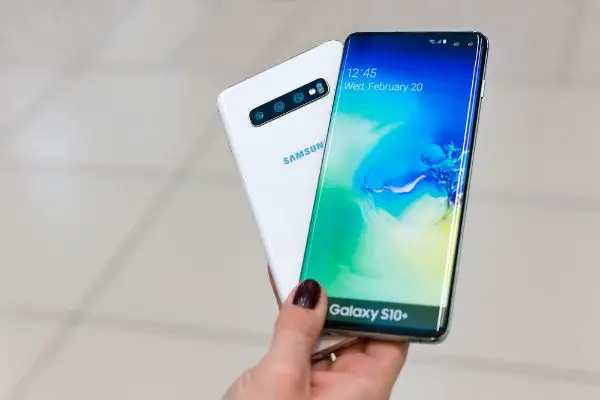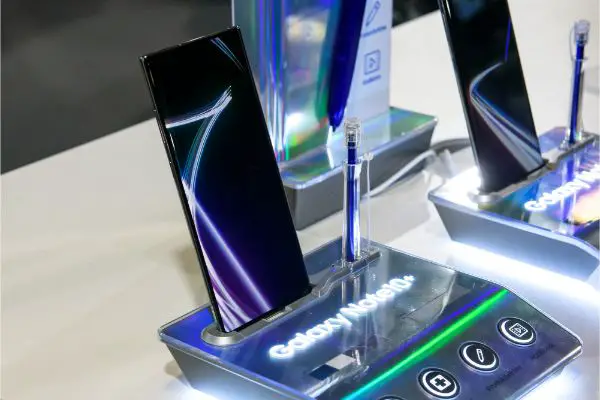Disclaimer: This post may contain affiliate links, meaning we get a small commission if you make a purchase through our links, at no cost to you. For more information, please visit our Disclaimer Page.
In the tech world, a bezel display is a border that usually exists between a screen and a phone’s frame. Bezels have been around for a while. Today, however, most manufacturers are now designing new screens with reduced bezel width. A good example is the “Infinity-O Display,” introduced by Samsung.

(Attribution: ©[nemanjazotovic]/Depositphotos.com)
Table of Contents
What is an Infinity-O display? (A more in-depth take)
The “notch” screen design is something that was introduced in 2017 by two popular smartphones; Apple’s iPhone X and the Essential Phone – a discontinued Android smartphone created by Andy Rubin.
In 2018, almost all manufacturers generally accepted the use of “notch” on smartphones across the globe, except Samsung and a few others. At the time, many flagship smartphones came with a notch design.
As mentioned above, Samsung was one of the few manufacturers that weren’t a big fan of the notch screen. Instead of using the design, Samsung introduced a couple of infinity displays in 2018, one of them is the infinity-O display.
Alongside the notch design, many smartphones released some years back also came with “wide bezels” on their screens. In case you don’t know, bezels are simply the borders that usually exist between a phone’s screen and its frame.
With producing smartphones, the bezel is, no doubt, one factor that manufacturers consider. In the past years, most smartphones were released with enormous bezels. However, in a way to achieve a better screen-to-body ratio, manufacturers are now coming up with unique designs that’ll help reduce the bezels on their modern smartphones.
That said, the Infinity-O display is something that Samsung thought of and released several years ago. Speaking of its design; you can say it’s a bezel-less screen engineered to offer more screen space.
You need to understand that “bezel-less,” as used in the context above, doesn’t mean that the screen doesn’t have any bezel. Instead, it means that the bezel is reduced as much as possible, providing more screen space. The purpose of the reduction in the bezel is simple; it makes it pretty easy for manufacturers to increase the screen-to-body ratio of their smartphones.
Besides the near bezel-less screen design, when introducing the Infinity-O display, according to Samsung , they “used accurate laser cutting technology to create a cut-out in the upper corner” of the screen, where the selfie camera is positioned.
Furthermore, the Infinity-O display is utilized on most modern Samsung smartphones, including the Galaxy S20, S20+, S21, S20 Ultra, S10, S10e, S10+, Galaxy Note10, and Galaxy Note10 Plus. More models that use the Infinity-O display can be found here.
The bottom line is that the Infinity-O display is a near-bezel-less screen introduced by Samsung on its smartphones to help deliver more screen space.
Is the Infinity-O Display AMOLED?
Before addressing this question, let me start by talking about what both Infinity-O display and AMOLED mean.
Starting with the Infinity-O display; you already know that it’s a marketing term used by Samsung for its smartphones’ display.
You can say that Infinity-O is a bezel-less display that allows Samsung to increase the screen-to-body ratio of its products. Additionally, you can also refer to Infinity-O as a full-frontal and edge-to-edge display.
As for the AMOLED display; here’s what you need to know about it below:
- The LED part of AMOLED means Light Emitting Diode. Like the technology that you’ll find in most homes, LED is a semiconductor light source, which is engineered to emit visible light when current flows through it. That said, a LED display is a display technology that utilizes an array of LEDs as pixels for a video display.
- As for the “O” in AMOLED; it stands for Organic. But what exactly does it mean? It’s simple; it means that the AMOLED display comes with a series of thin organic material films. The films are placed in between two different conductors in each of the light-emitting diodes. When current is applied, the thin organic films are used to produce light.
- As for the AM part of the AMOLED display; it stands for Active Matrix. In case you don’t know, there’s a big difference between an Active Matrix and a Passive Matrix.
- In an Active Matrix, a TFT or thin-film transistor and a capacitor are both attached to each of the sub-pixel light-emitting diodes. This is not the same for Passive Matrix, which only involves using a complex grid system to control individual pixels LED.
One benefit of the AMOLED display is that it uses a plastic substrate, which is thin and light. Another interesting thing about the substrate is that it doesn’t break easily. That’s not all; the plastic substrate also provides better shock absorption.
Furthermore, AMOLED provides great viewing angles and maintains battery life. One setback of this display, however, is that it’s very expensive. This explains why most of Samsung’s curved products are expensive to purchase.
Let me pause here and go back to the question of; is the infinity-O display AMOLED?
The simple and direct answer is no. The Infinity-O display is not directly AMOLED. However, you can say that it’s a form of Super AMOLED, another marketing term used by Samsung.
According to Samsung, the Super AMOLED display is a display that’s designed with an integrated touch function. It comes with a layer, which is integrated directly into the screen.
The bottom line is that Samsung’s Infinity-O display is a Super AMOLED unit.

(Attribution: ©[gints.ivuskans]/Depositphotos.com)
What are the benefits of an Infinity-O display?
There are tons of benefits attached to using a smartphone with the Infinity-O display. One of them is that it provides its users with a bigger screen. Let’s have a look at some other benefits of the Infinity-O display below:
Bigger screen
As you already know, one benefit of the Infinity-O display is that it delivers a bigger screen. Here’s the thing; this display is a bezel-less screen; meaning that the bezel has been reduced to achieve a better screen-to-body ratio.
One advantage of having a higher screen-to-body ratio is that it’ll provide a wide viewing angle on display. If you’re the type that enjoys watching videos are playing games on your smartphone, you’ll certainly like the Infinity-O display.
Gorgeous display
Another enormous advantage of using a bezel-less, edge-to-edge screen is that it’ll provide you with a gorgeous display. Yes, the Infinity-O display often makes smartphones look very stylish and textured. If you’re a lover of gorgeous displays, you’ll certainly love this display.
Space utilization
Another good thing about the Infinity-O display is that it provides more space and less overhead. Before now, most screens came with a 16:9 ratio; the problem with this display is that it delivers enormous bezels.
Today, however, bezel-less screens are available in different aspect ratios, including 18:9,18.5:9, and 19:9. They provide room for more space utilization.
Better viewing angle
The viewing angle is a very important factor to consider with choosing the best smartphone display. It’s one factor that determines the quality of your smartphone screen. With a bezel-less, edge-to-edge screen delivered by the Infinity-O display, you can always enjoy a better viewing angle.
References
- https://www.samsung.com/global/galaxy/what-is/infinity-o-display/
- https://www.britannica.com/technology/LED
- https://www.samsung.com/global/galaxy/what-is/super-amoled/
- https://www.androidauthority.com/amoled-vs-lcd-vs-retina-vs-infinity-display-801135/
- https://www.sammobile.com/samsung/infinity-o-display
